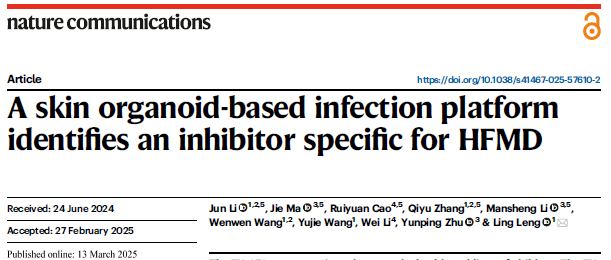Recently, Nature journal Nature Communications (a tier 1 journal, ranked among the top 5% by the Chinese Academy of Sciences, IF=14.7) published a journal article on research findings from Researcher Ling Leng's team at PUMCH. The team established a skin organoid infection model to thoroughly investigate the infection mechanism of enterovirus A71 (EV-A71) and successfully identified an inhibitor targeting this virus. This breakthrough provides new directions for clinical prevention and treatment of hand, foot and mouth disease (HFMD). The research was supported by the National Key R&D Program and the Central High-Level Hospital Clinical Research Funding, among others.

EV-A71, which spreads through skin contact, is the primary pathogen causing severe HFMD, posing a serious threat to children's health. The most common symptoms of EV-A71 infection include low-grade fever with discomfort, yellowish papules or blisters on the hands, feet, and buttocks, and painful ulcerative lesions in the throat, mouth, and tongue. EV-A71 is also highly neurotropic, capable of invading the nervous system and potentially causing meningitis, neurogenic pulmonary edema, and acute flaccid paralysis, sometimes with fatal outcomes. To date, no animal model can simulate all symptoms of human EV-A71 infection, which makes it urgent to develop physiologically relevant human models for systematic research.
In this study, the team used human induced pluripotent stem cells to establish a skin organoid infection model, including epidermis, dermis, hair follicles, sebaceous gland appendages, subcutaneous fat, and nerve bundles composed of neurons and Schwann cells. This skin organoid resembles natural skin in cellular composition, microstructure, and physiological function.
The research found that multiple cell types—including epidermal cells, hair follicle cells, fibroblasts, and nerve cells—express EV-A71 receptors and are susceptible to EV-A71 infection. In the early stages of infection, EV-A71 replicates extensively in host cells; in late stages, EV-A71 directly triggers immune and hypoxic responses in host cells.
In the dermal structure, EV-A71 infection causes a reduction in reticular fibroblasts and loss of dermal collagen, affecting the structural support capacity of dermal tissue, disrupting immune response balance, and accelerating skin aging. In the epidermal structure, EV-A71 infection leads to epidermal cell dysfunction and inflammatory responses.
Further research revealed that EV-A71 causes disease by affecting two physiological processes in host cells. On one hand, EV-A71 can destroy the epidermal stem cell niche and normal autophagy processes; on the other hand, EV-A71 infection promotes intense proliferation of a type of progenitor cell (NNMT+SFRP1+PCs) through specific signaling pathways.
After clarifying the viral pathogenesis mechanism, the research team inferred that the autophagy protein HMGB1 could be a potential target for EV-A71 infection. Through high-throughput drug screening, the team discovered a small molecule inhibitor targeting HMGB1 that can effectively inhibit EV-A71 replication. Through in vitro experiments with skin organoids and animal experiments with humanized skin organoids, the team demonstrated that this inhibitor has significant antiviral effects and alleviates the inflammatory response and potential tumor risk caused by viral infection, illuminating new research directions for clinical treatment of HFMD.
Written by Leng Ling and Gan Dingzhu
Edited by Gan Dingzhu and Chen Xiao
